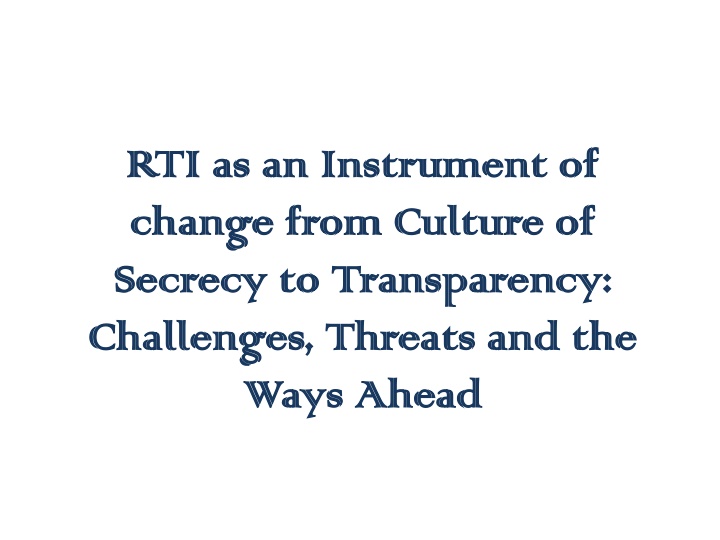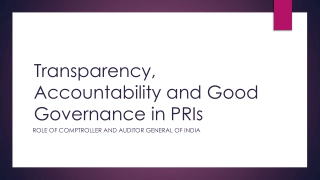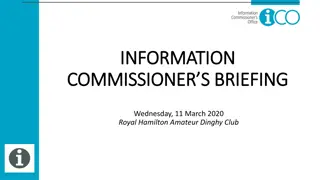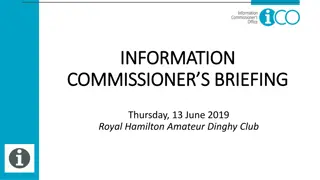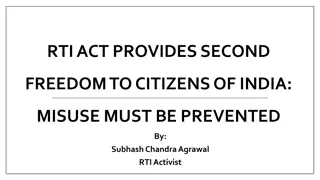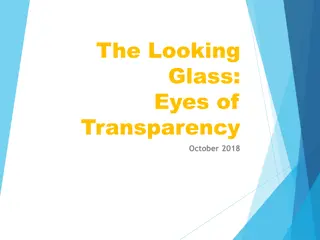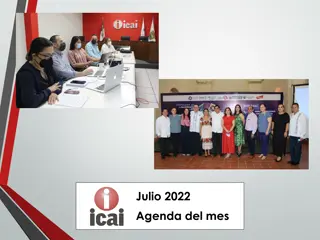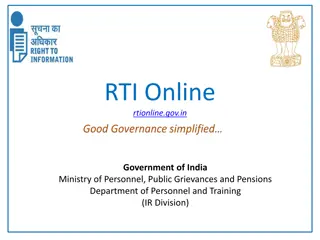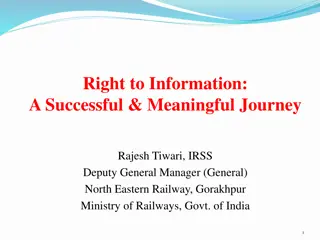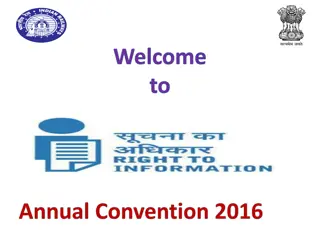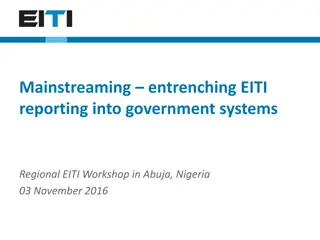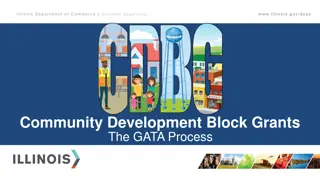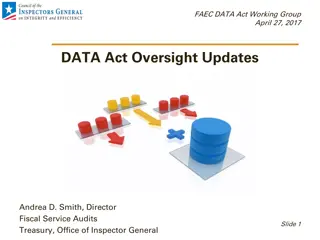Impact of Right to Information Act on Transparency and Accountability: Challenges and the Way Forward
The Right to Information Act is a crucial tool in transforming the culture of secrecy to transparency. It aims to promote accountability, eradicate corruption, and empower citizens. However, the implementation of RTI faces challenges such as lack of proactive thinking in bureaucracy and infrastructural constraints. The study delves into the extent of RTI's influence on decision-making, public participation, and more, highlighting the need to address knowledge gaps for effective outcomes.
Download Presentation

Please find below an Image/Link to download the presentation.
The content on the website is provided AS IS for your information and personal use only. It may not be sold, licensed, or shared on other websites without obtaining consent from the author.If you encounter any issues during the download, it is possible that the publisher has removed the file from their server.
You are allowed to download the files provided on this website for personal or commercial use, subject to the condition that they are used lawfully. All files are the property of their respective owners.
The content on the website is provided AS IS for your information and personal use only. It may not be sold, licensed, or shared on other websites without obtaining consent from the author.
E N D
Presentation Transcript
RTI as an Instrument of RTI as an Instrument of change from Culture of change from Culture of Secrecy to Transparency: Secrecy to Transparency: Challenges, Threats and the Challenges, Threats and the Ways Ahead Ways Ahead
Authors Amaresh Jha Ph. D. Research Scholar, Amity School of Communication, Amity University, Uttar Pradesh & Dr. Aman Vats Associate Professor, Amity School of Communication, Amity University, Uttar Pradesh
Right to Information Act, 2005 INTRODUCTION The Right to Information is an internationally protected right. RTI is protected by Universal Declaration of Human Rights, the International Covenant on Civil and Political Rights The Right to Information campaign in India began in the early 1990s. The Mazdoor Kisan Shakti Sangathan started in rural area of Rajastan. (Hum Janenge, Hum Jiyenge) The main aim of the RTI Act is to set a practical regime for citizens to secure access to information
Core objectives of the Right to Information Act, 2005 Setting out the practical regime of right to information for citizens Promoting transparency and accountability in the working of the government Eradication of any type of corruption in the working of public authority Maintaining all the documents held by public authority taking self initiatives
Objective of the Study 1. To what extent RTI has led to transparency and accountability? 2. In what ways RTI has affected decision making? 3. Has RTI been instrumental in public participation in governance? 4. Has RTI led to lack of proactive thinking in bureaucracy? 5. What are the infrastructural challenges in meeting the objectives of RTI?
Knowledge Gap With the review of literature researchers has identified An urgent need to take stock of different aspects of effectiveness of the RTI Act. Enable quick corrective actions or interventions by the Government, by the Commissions themselves and by the civil society groups. Know who or which sections of people are taking advantages of the RTI Act. Identify whether media advocacy has played any role in making a difference as far as reach and usage of the RTI Act is concerned. Whether there has been any change in the mindset of people responsible for the implementation of the RTI Act.
Theoretical framework To make an assessment of the shift from a culture of Secrecy; Resource Dependence and Institutional theories were used as theoretical framework. Stakeholder analysis is best suited for scanning the organization's external environment in order to identify opportunities and threats as well as to improve the exercise of the organization's value judgment. The external environment of an organization defines the critical elements of its competitive strategy. This study therefore measure as to what extent the RTI Act has met its core objectives of transparency, accountability, public participation and better decision making.
Data and Measures Finding1. RTI has led to transparency and accountability?
Data and Measures Finding2. RTI has affected decision making?
Data and Measures Finding 3 Has RTI been instrumental in public participation?
Data and Measures Finding 4 Has RTI Act led to lack of proactive thinking in the governance?
Data and Measures Finding 5 Lack of manpower/infrastructure obstacle in implementation of the Act?
CONCLUSION The findings of this study have clear reflection that RTI has met its core objective of transparency and accountability, but it has yet to do lot on improving the infrastructure Participation as a tool of empowerment is well established, however, the study demonstrates that public participation has not reached the desired levels despite the RTI The RTI Act has increased the trust in government and there is a feeling that transparency and accountability in governance has increased. There is a clear shift from culture of secrecy to culture of transparency and RTI Act has proved very instrumental in bringing this change
RECOMMENDATIONS The achievements of the RTI Act need to be publicized because this will increase a sense of containment among citizens . RTI Act has proved to be the most crucial instrument in empowering people with a right to compel the public authorities to disclose the information held with them. Mass awareness campaign at central and state level is needed to achieve the goal of more and more participation of citizens in governance.
